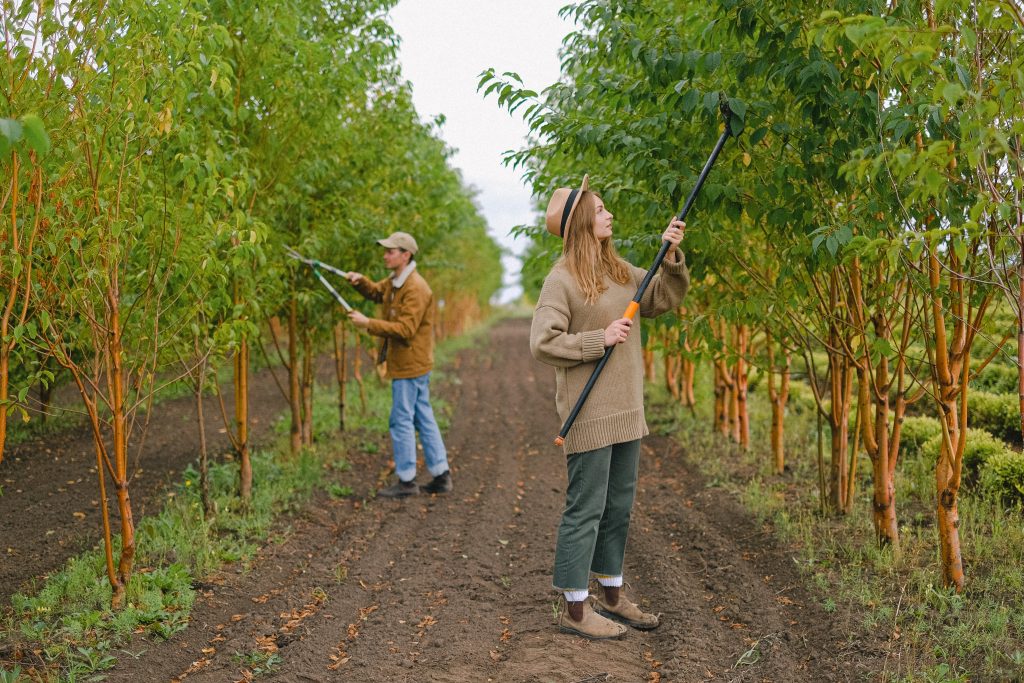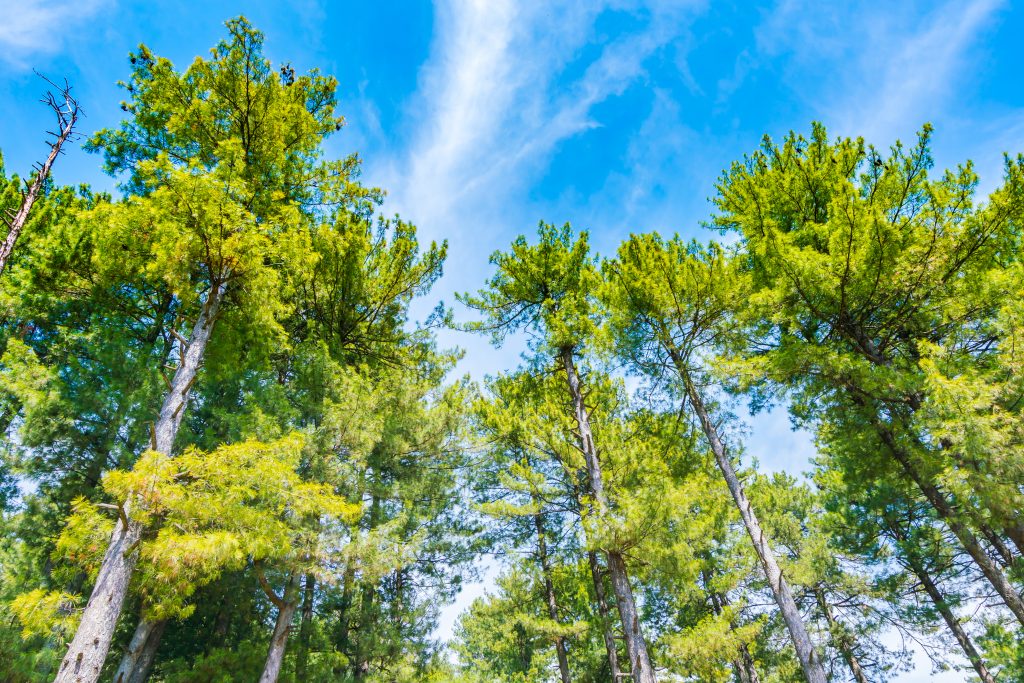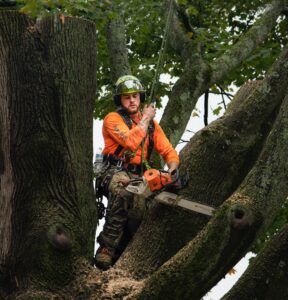THE BENEFITS OF USING RECYCLED MATERIALS FOR TREE CARE
THE BENEFITS OF USING RECYCLED MATERIALS FOR TREE CARE
In an era where environmental sustainability is at the forefront of global consciousness, every industry is being challenged to find innovative ways to minimize its ecological footprint. Arboriculture, the cultivation and management of trees, is no exception. As urban landscapes continue to expand, the importance of sustainable tree care practices becomes increasingly evident. One notable approach gaining traction within the arboriculture field is the utilization of recycled materials. This article explores the benefits and implications of integrating recycled materials into tree care practices.

Recycled Materials: Redefining Tree Care
Recycled materials in tree care encompass a wide range of resources, from yard waste and wood chips to compost and organic matter sourced from local communities. These materials, often repurposed from waste streams, can play a significant role in nurturing healthy trees and promoting sustainable urban ecosystems.
Environmental Benefits
At the heart of using recycled materials lies the principle of waste reduction. The arboriculture industry generates substantial amounts of tree waste, including branches, leaves, and wood debris. By recycling these materials into useful products like mulch and compost, we not only divert waste from landfills but also minimize the need for new resources. This translates into a lower carbon footprint and less strain on precious natural resources.
Soil Health and Fertility
Recycled organic materials, such as wood chips and compost, can be a boon for soil health. Mulching with recycled wood chips enhances soil structure, facilitating root growth and improving aeration. Organic matter also enriches soil fertility by releasing essential nutrients over time, reducing the need for synthetic fertilizers. Furthermore, mulch helps conserve soil moisture, reducing irrigation demands and promoting efficient water use.
Tree Health and Growth
Healthy soil is the foundation for thriving trees. Recycled mulch aids in controlling weed growth, minimizing competition for resources and maximizing nutrient availability to trees. The slow-release nutrients from organic materials provide a sustained source of nourishment, fostering steady growth and resilience against stressors.
Water Conservation
As water scarcity becomes a global concern, efficient water management practices are crucial. Recycled mulch plays a pivotal role in water conservation by preventing soil evaporation and runoff. This helps trees weather droughts and reduces the strain on water resources.
Pest and Disease Management
Innovative tree care approaches also touch upon pest and disease management. By utilizing recycled materials that promote biodiversity and encourage beneficial organisms, such as certain fungi and insects, arborists can create an ecosystem that naturally suppresses pests and pathogens. This reduces the reliance on chemical interventions, contributing to a healthier environment.
Cost Efficiency and Community Engagement
Recycled materials bring economic benefits too. By reducing disposal costs and the need for external inputs, tree care professionals can operate more efficiently and cost-effectively. Additionally, adopting sustainable practices resonates with communities that prioritize environmental responsibility, thereby strengthening community bonds and promoting a shared sense of stewardship.
Challenges and Considerations
While the advantages of using recycled materials in tree care are substantial, there are challenges to overcome. Sourcing quality recycled materials, ensuring their safety, and tailoring practices to specific tree species and environments require careful consideration.
Conclusion
The integration of recycled materials into tree care practices is not just a nod to sustainability; it’s a proactive step toward creating healthier urban ecosystems. By repurposing waste into valuable resources, arborists can improve tree health, conserve water, reduce costs, and foster community engagement. As the world looks for ways to harmonize human activities with the environment, the arboriculture industry showcases the transformative potential of recycled materials in creating a greener future.
Tree care and environmental conservation are essential for maintaining the health of ecosystems, preserving biodiversity, mitigating climate change, and ensuring a sustainable future for both human and natural communities. Here’s a breakdown of their importance:

- Ecosystem Health: Trees play a crucial role in various ecosystems, providing habitat and food sources for numerous species. They contribute to the overall health and balance of ecosystems, supporting diverse plant and animal communities.
- Biodiversity: Trees are part of intricate food webs and support a wide range of organisms. When trees are well-maintained and conserved, they help preserve biodiversity by providing habitats for various species, including insects, birds, and mammals.
- Air Quality: Trees are natural filters that absorb pollutants and release oxygen through photosynthesis. They improve air quality by removing harmful gases, such as carbon dioxide, sulfur dioxide, and nitrogen oxides, from the atmosphere.
- Climate Change Mitigation: Trees are carbon sinks, absorbing carbon dioxide from the atmosphere and helping to offset the impacts of climate change. By conserving and planting trees, we can reduce greenhouse gas emissions and their effects on global warming.
- Soil Protection: Tree roots prevent soil erosion and help maintain soil structure. They also contribute to nutrient cycling, promoting healthy soil for plant growth and ecosystem stability.
- Water Management: Trees play a role in regulating water cycles. They absorb and store water, reducing the risk of floods and promoting groundwater recharge. Trees also release moisture into the atmosphere through a process called transpiration, which influences local and regional rainfall patterns.
- Aesthetic and Recreational Value: Trees enhance the beauty of landscapes and provide spaces for recreation and relaxation. Parks, green spaces, and urban forests contribute to the well-being of communities and individuals.
- Cultural and Historical Significance: Trees often hold cultural and historical significance for communities, serving as symbols of heritage, identity, and memory.
- Economic Benefits: Proper tree care contributes to the economy by supporting industries like forestry, agriculture, and tourism. Trees can increase property values, attract tourists, and provide resources such as timber and fruits.
- Education and Awareness: Trees and natural environments offer opportunities for education and research, helping us better understand ecosystems, biodiversity, and the importance of conservation.
- Long-Term Sustainability: By practicing responsible tree care and environmental conservation, we ensure that future generations can enjoy the same benefits and resources that we do today. This approach aligns with the principles of sustainability and intergenerational equity.
In summary, tree care and environmental conservation are vital for maintaining ecological balance, addressing climate change, and promoting the well-being of both the natural world and human societies. Through conscious efforts to protect and nurture trees and their ecosystems, we contribute to a healthier, more resilient planet.
Moreover, here are the benefits of using recycled materials for tree care that you can discuss in your essay:
- Resource Conservation: Using recycled materials for tree care reduces the demand for new resources, such as timber and fossil fuels. This helps conserve natural resources and minimizes the environmental impact associated with resource extraction and production.
- Waste Reduction: Recycling materials like wood chips, leaves, and branches for tree care prevents organic waste from entering landfills. This reduces the volume of waste in disposal sites and contributes to a more sustainable waste management system.
- Lower Energy Consumption: Recycling materials requires less energy compared to extracting, refining, and processing new raw materials. By using recycled materials for tree care, you contribute to energy conservation and help reduce greenhouse gas emissions associated with energy production.
- Carbon Footprint Reduction: Recycling materials for tree care helps lower carbon emissions. It avoids the energy-intensive processes involved in creating new materials and reduces the overall carbon footprint associated with tree care practices.
- Natural Pest Control: Recycled materials can serve as natural alternatives for pest control. For example, using mulch made from recycled organic materials can create a barrier against weeds and pests, reducing the need for chemical pesticides.
- Improved Soil Health: Recycled materials like compost and mulch enrich the soil with essential nutrients and improve its structure. Healthy soil supports tree growth, water retention, and nutrient cycling, leading to better overall tree health.
- Promotion of Circular Economy: Using recycled materials in tree care promotes the concept of a circular economy, where materials are reused, repurposed, and recycled to extend their lifespan. This reduces the linear “take-make-dispose” model of resource consumption.
- Local Sourcing: Recycled materials often come from local sources, reducing the carbon footprint associated with transportation. This supports local economies and reduces the environmental impact of long-distance material transport.
- Community Engagement: Initiatives that involve the use of recycled materials for tree care can engage and educate local communities about sustainable practices. This fosters a sense of environmental responsibility and encourages more people to participate in conservation efforts.
- Cost Savings: In some cases, using recycled materials can be more cost-effective than purchasing new materials. For instance, using wood chips from tree pruning as mulch can save money compared to buying commercial mulch.
- Positive Public Image: Organizations and individuals that prioritize environmental conservation by using recycled materials for tree care can enhance their public image and reputation as responsible stewards of the environment.
- Long-Term Sustainability: Incorporating recycled materials into tree care practices contributes to the long-term sustainability of ecosystems, urban landscapes, and the environment as a whole.
By discussing these benefits in your essay, you can provide a comprehensive understanding of the advantages associated with using recycled materials for tree care and highlight the positive impact such practices can have on both the environment and society.
About Murray, Utah
Murray is a city situated on the Wasatch Front in the core of Salt Lake Valley in the U.S. state of Utah. Named for territorial governor Eli Murray, it is the state's fourteenth largest city. According to the 2020 census, Murray had a population of 50,637. Murray shares borders with Taylorsville, Holladay, South Salt Lake and West Jordan, Utah. Once teeming with heavy industry, Murray's industrial sector now has little trace and has been replaced by major mercantile sectors. Known for its central location in Salt Lake County, Murray has been called the Hub of Salt Lake County. Unlike most of its neighboring communities, Murray operates its own police, fire, power, water, library, and parks and recreation departments and has its own school district. While maintaining many of its own services, Murray has one of the lowest city tax rates in the state.
Neighborhoods in Murray, Utah
Murray Oakes, Grant Park, Southwood Park, Murray Park, Murray Park Restrooms, Willow Pond Park, Neighborhood Veterinary Care
Things To Do in Murray, Utah
Bus Stops in Murray, Utah to Truco Services, Inc.
Bus Stop in Murray Central Station (Bay C) Murray, Utah to Truco Services, Inc.
Bus Stop in State St @ 4801 S Murray, Utah to Truco Services, Inc.
Bus Stop in Murray North Station Murray, Utah to Truco Services, Inc.
Bus Stop in State St @ 4949 S Murray, Utah to Truco Services, Inc.
Bus Stop in Murray Central Frontrunner/Trax Station Murray, Utah to Truco Services, Inc.
Bus Stop in Murray Blvd / Vine St (SB) Murray, Utah to Truco Services, Inc.
Bus Stop in State St @ 3925 S Murray, Utah to Truco Services, Inc.
Bus Stop in State St @ 4824 S Murray, Utah to Truco Services, Inc.
Bus Stop in State St @ 5223 S Murray, Utah to Truco Services, Inc.
Bus Stop in Murray Blvd / Allendale Dr (NB) Murray, Utah to Truco Services, Inc.
Bus Stop in Murray Blvd @ 5039 S Murray, Utah to Truco Services, Inc.
Bus Stop in State St @ 4721 S Murray, Utah to Truco Services, Inc.
Driving Directions in Murray, Utah to Truco Services, Inc.
Driving Directions from Woodruff Tree Trimming and Removal to 4640 Commerce Dr, Murray, UT 84107, USA
Driving Directions from Reliable Tree Care to 4640 Commerce Dr, Murray, UT 84107, USA
Driving Directions from Tree Pro-Tech to 4640 Commerce Dr, Murray, UT 84107, USA
Driving Directions from Prestige Tree And Landscape to 4640 Commerce Dr, Murray, UT 84107, USA
Driving Directions from Excellence Tree & Landscape to 4640 Commerce Dr, Murray, UT 84107, USA
Driving Directions from Amen Trees to 4640 Commerce Dr, Murray, UT 84107, USA
Driving Directions from Tim's Tree Care to 4640 Commerce Dr, Murray, UT 84107, USA
Driving Directions from Jordan Tree Service - Murray to 4640 Commerce Dr, Murray, UT 84107, USA
Driving Directions from Arbor Works to 4640 Commerce Dr, Murray, UT 84107, USA
Driving Directions from Diamond Tree Experts to 4640 Commerce Dr, Murray, UT 84107, USA
Driving Directions from Green Tree Arborist to 4640 Commerce Dr, Murray, UT 84107, USA
Driving Directions from TruCo Services to 4640 Commerce Dr, Murray, UT 84107, USA
Reviews for Truco Services, Inc. Murray, Utah
Emily Abercrombie
We had a great experience with TruCo! They were well priced, responsive and prompt. Michael was a pleasure to work with and gave us advice on which plants to put in where we took out our ugly old shrubs. I would highly recommend this company!!!
Michelle Turpin
TruCo Services gets 5 stars from us for customer service. We experienced a few issues with their services this last year and Rob Eccles in senior management, stepped in and immediately handled our issues. He was very committed to making sure they understood our expectations and would execute to make us happy.
Siobhan Billingsley
I work for a property management company and have the pleasure of working with Rob at a community in Sandy. He has been incredible to work with and always responds in a timely manner. He knows all the homeowners by name and address and is aware of all the "problem" areas when it comes to sprinklers. I never have to worry about following up with him because he always reaches out to provide me with an update. If you're looking to work with someone who takes pride in their job, is professional, and can solve the worst landscaping problems thrown your way, Rob is your guy. Thank you, Rob for all you do!
Jaime S.
We have used Truco at 2 of the complexes we manage, they have been great to work with. Good quality service, outstanding customer service with good communication. That's hard to find these days. I highly recommend them. Travis has been awesome to work with.
Jerusha Smart
We use TruCo for a majority of our properties and our home. While other landscaping companies we use come and go for various reasons like cost, communication issues, work performance, etc., TruCo is always consistent in price and work. Also, Rob is the best.
